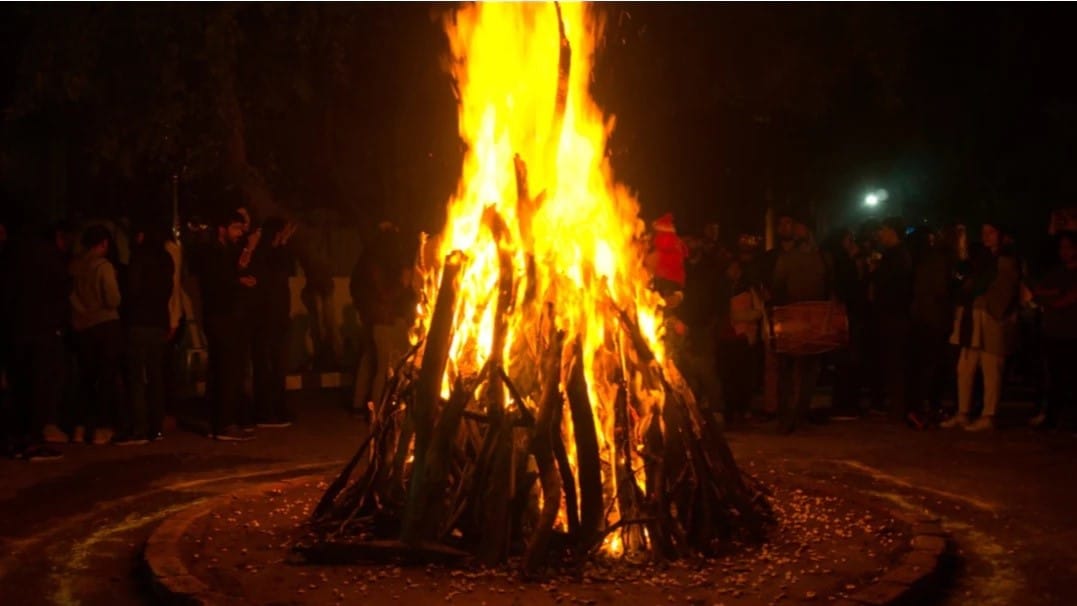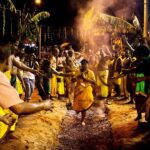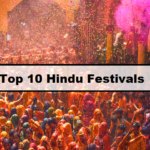The Hindu festival Holika Dahan, also known as Chhoti Holi or Holika Deepak, celebrates the triumph of good over evil. It is observed on the day of the full moon in the Hindu month of Phalguna, which occurs annually in February or March. The festival marks the beginning of spring and is widely observed throughout India. Holika Dahan is celebrated with a lot of energy and is a time for friends and family to get together and have fun. It is a religious holiday marked by numerous rituals that are observed with great reverence on this day. In this blog, we will examine the history and significance of Holika Dahan, as well as its associated customs and traditions and celebrations in India.
History and Legend
Holika Dahan is based on Hindu mythology and has a long history. The celebration of the festival dates back many centuries and is held to honor the triumph of good over evil. Legend has it that a powerful demon king by the name of Hiranyakashipu once received a blessing that made him virtually invincible. He demanded that everyone worship him as if he were a god and claimed to be immortal. However, his son Prahlad devoted himself to Lord Vishnu, a god his father detested, and refused to worship him.

Hiranyakashipu was furious and tried to kill his son several times, but Lord Vishnu miraculously saved him each time. Finally, Hiranyakashipu asked his sister Holika to enter a raging fire with Prahlad in her lap because she was blessed with an immunity to fire. In the hope that she would be able to end Prahlad’s life and survive the fire, Holika granted her brother’s request. However, Holika’s shawl was blown onto Prahlad by Lord Vishnu, who intervened and saved him from the fire. Holika, on the other hand, perished in the fire.
Holika Dahan is the annual celebration of this event, which celebrates the triumph of good over evil. The festival serves as a reminder that the power of good can always overcome evil, regardless of how formidable it may appear. An important aspect of the festival is the burning of Holika’s effigy on Holika Dahan, which symbolizes the victory of good over evil. In addition, the festival is a time when people pray to Lord Vishnu and ask for his help.
Customs and Traditions
The Holika Dahan festival is marked by numerous traditions and customs. The following are some of the festival’s customs and traditions:
How to set up and decorate the bonfire for Holika: Individuals assemble wood and different materials to construct a huge fire, which is then finished with blossoms, wreaths, and different contributions. When the bonfire is lit, it usually happens after sunset.

Holika Dahan is celebrated with the following puja practices: Pray, perform puja rituals, and seek Lord Vishnu’s blessings are all part of the celebration. A priest leads the puja, giving flowers, sweets, and other offerings to the deity in addition to performing aarti.
Burning of Holika’s effigy: Holika’s effigy is made and burned in the bonfire. The effigy is evil and is made of materials that can burn. People sing and dance around the fire as the effigy burns.
The significance of the bonfire’s ashes: Ashes from a bonfire are regarded as holy and are thought to have the ability to cleanse the soul. The ashes are smeared all over people’s bodies and applied to their foreheads.

Festive beverages and food: For the occasion, special dishes like gujiya, mathri, dahi bhalla, and thandai are made. Milk, sugar, and a variety of spices are used to make the traditional beverage known as thandai.
Holika Dahan is a time when friends and family get together to commemorate the triumph of good over evil. The season is one of celebration, amusement, and spiritual renewal. The festival is also a chance to build relationships with loved ones and spread joy and kindness.
Celebration across India
In all of India, Holika Dahan is celebrated with a lot of enthusiasm. The celebration is marked by a variety of regional customs and traditions, but the core message is the triumph of good over evil. In India, the following are some of the ways that Holika Dahan is celebrated:
North India: Holika Dahan is celebrated with great enthusiasm in North India. People dance around bonfires, light them up, and sing hymns to Lord Vishnu. Holi, which is also known as the festival of colors, is celebrated on the day that comes after Holika Dahan. Water and colored powder are used to smear each other, and sweets and greetings are exchanged.

South India: Holika Dahan is celebrated in South India as Kamadahanam, a retelling of the story of Prahlad and Hiranyakashipu. People pray for Lord Vishnu’s blessings before lighting the Holika effigy in the bonfire.
West India: In West India, Holika Dahan is commended with a ton of excitement. Around the bonfires, people sing and dance. Dhulandi, also known as Rangwali Holi, is the day that comes after Holika Dahan. Water and colored powder are used to smear each other, and sweets and greetings are exchanged.

East India: Holika Dahan is celebrated with great devotion in East India. Bonfires are lit, prayers are said, and people pray for Lord Vishnu’s blessings. The day following Holika Dahan is commended as Dol Purnima, which is otherwise called Basanta Utsav. Singing and dancing to traditional folk songs, participants smear each other with colored powder and water.
A festival like Holika Dahan brings people together and spreads happiness. The festival reminds us to always stand up for what is right and celebrates the triumph of good over evil. It’s a good time to reconnect with loved ones and spread peace and love.
Holika Dahan in the Modern World
Holika Dahan is a festival that has been celebrated for centuries and is still significant in the modern world. However, over time, the festival’s meanings and interpretations have changed. In today’s world, some of the ways Holika Dahan is celebrated are as follows:
Concerns about the environment: Many people are now choosing eco-friendly ways to celebrate Holika Dahan because of the growing awareness of environmental issues. They build the bonfire with natural materials, don’t burn plastic or other harmful materials, and plant trees after the festival.

Media online: People are increasingly using social media to share their Holika Dahan celebrations. People connect with loved ones who live far away by sharing greetings, posting videos and pictures of their celebrations.
Commercialization: The sale of traditional sweets, decorations, and other items has made Holika Dahan into a festival that is now dominated by business. On the other hand, a lot of people are now opting for locally sourced handmade goods, which support local artisans and encourage sustainable practices.

Culture transfer: The Holika Dahan festival has evolved into one that brings people from various communities and cultures together. Holika Dahan celebrations now attract a large number of people from all walks of life, religious or cultural. As a result, there has been a cultural exchange and a deeper appreciation for various traditions.
Holika Dahan is still a festival that highlights the importance of standing up for what is right and celebrates the victory of good over evil. It’s a time to bond with loved ones, raise awareness of the environment, and spread joy and love. In the advanced world, Holika Dahan has taken on new implications and translations, yet the embodiment of the celebration stays unaltered.
Conclusion
In India, the Holika Dahan festival has been celebrated for centuries. It is a festival that highlights the significance of standing up for what is right and celebrates the victory of good over evil. India celebrates the festival with a variety of customs and traditions, and it has a long and interesting legend.
Holika Dahan has taken on new meanings and interpretations in today’s world, with a greater emphasis on cultural exchange, social media sharing, and environmental sustainability. However, the essence of the festival is still the same: it’s a time to bond with loved ones, spread love and peace, and celebrate good’s victory over evil.
A festival like Holika Dahan brings people together and spreads happiness. Let us remember the message that this festival conveys, which is to always defend what is right and to spread love and peace throughout the world, as we celebrate it.
FAQs
When is Holika Dahan celebrated?
In the Hindu month of Phalguna, Holika Dahan is celebrated the night before the full moon. According to the Gregorian calendar, it typically occurs in either February or March.
What significance does Holika Dahan have?
Holika Dahan is a symbol of good triumphing over evil. This festival commemorates Prahlad’s victory over his father, Hiranyakashipu, the demon king, and Lord Vishnu’s protection of Prahlad.
What kinds of traditions and customs are associated with Holika Dahan?
In order to obtain Lord Vishnu’s blessings, Holika Dahan is celebrated with bonfire lighting, dancing, and puja. On the day after Holika Dahan, which is also known as Holi, people also smear each other with colored powder and water.
In India, how is Holika Dahan celebrated?
In every part of India, Holika Dahan is marked by regional customs and traditions. People in the north of India light bonfires and sing hymns to Lord Vishnu. Holika Dahan is celebrated in South India as Kamadahanam, a retelling of the story of Prahlad and Hiranyakashipu. In West India, people dance and sing around a bonfire, while in East India, people celebrate Dol Purnima or Basanta Utsav and pray to Lord Vishnu.
What role has Holika Dahan played in today’s world?
Holika Dahan has taken on new meanings and interpretations in today’s world, with a greater emphasis on cultural exchange, social media sharing, and environmental sustainability. However, the festival’s core purpose of promoting love and peace and celebrating the triumph of good over evil remains unchanged.







